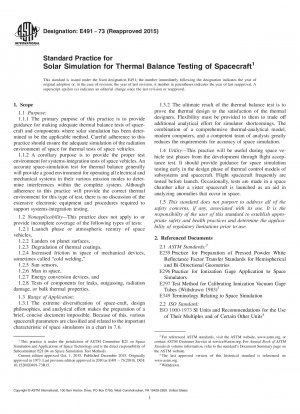ASTM E491-73(2015)
Standard Practice for Solar Simulation for Thermal Balance Testing of Spacecraft
- Standard No.
- ASTM E491-73(2015)
- Release Date
- 1973
- Published By
- American Society for Testing and Materials (ASTM)
- Status
- Replace By
- ASTM E491-73(2020)
- Latest
- ASTM E491-73(2020)
- Scope
1.1 Purpose:
1.1.1 The primary purpose of this practice is to provide guidance for making adequate thermal balance tests of spacecraft and components where solar simulation has been determined to be the applicable method. Careful adherence to this practice should ensure the adequate simulation of the radiation environment of space for thermal tests of space vehicles.
1.1.2 A corollary purpose is to provide the proper test environment for systems-integration tests of space vehicles. An accurate space-simulation test for thermal balance generally will provide a good environment for operating all electrical and mechanical systems in their various mission modes to determine interferences within the complete system. Although adherence to this practice will provide the correct thermal environment for this type of test, there is no discussion of the extensive electronic equipment and procedures required to support systems-integration testing.
1.2 Nonapplicability—This practice does not apply to or provide incomplete coverage of the following types of tests:
1.2.1 Launch phase or atmospheric reentry of space vehicles,
1.2.2 Landers on planet surfaces,
1.2.3 Degradation of thermal coatings,
1.2.4 Increased friction in space of mechanical devices, sometimes called “cold welding,”
1.2.5 Sun sensors,
1.2.6 Man in space,
1.2.7 Energy conversion devices, and
1.2.8 Tests of components for leaks, outgassing, radiation damage, or bulk thermal properties.
1.3 Range of Application:
1.3.1 The extreme diversification of space-craft, design philosophies, and analytical effort makes the preparation of a brief, concise document impossible. Because of this, various spacecraft parameters are classified and related to the important characteristic of space simulators in a chart in 7.6.
1.3.2 The ultimate result of the thermal balance test is to prove the thermal design to the satisfaction of the thermal designers. Flexibility must be provided to them to trade off additional analytical effort for simulator shortcomings. The combination of a comprehensive thermal-analytical model, modern computers, and a competent team of analysts greatly reduces the requirements for accuracy of space simulation.
ASTM E491-73(2015) Referenced Document
- ASTM E259 Standard Practice for Preparation of Pressed Powder White Reflectance Factor Transfer Standards for Hemispherical and Bi-Directional Geometries*, 1998-04-20 Update
- ASTM E296 Standard Practice for Ionization Gage Application to Space Simulators*, 2020-11-01 Update
- ASTM E349 Standard Terminology Relating to Space Simulation*, 2019-10-01 Update
ASTM E491-73(2015) history
- 2020 ASTM E491-73(2020) Standard Practice for Solar Simulation for Thermal Balance Testing of Spacecraft
- 1973 ASTM E491-73(2015) Standard Practice for Solar Simulation for Thermal Balance Testing of Spacecraft
- 1973 ASTM E491-73(2010) Standard Practice for Solar Simulation for Thermal Balance Testing of Spacecraft
- 2004 ASTM E491-73(2004)e1 Standard Practice for Solar Simulation for Thermal Balance Testing of Spacecraft
- 1973 ASTM E491-73(2004) Standard Practice for Solar Simulation for Thermal Balance Testing of Spacecraft
- 1973 ASTM E491-73(1999) Standard Practice for Solar Simulation for Thermal Balance Testing of Spacecraft

Copyright ©2024 All Rights Reserved